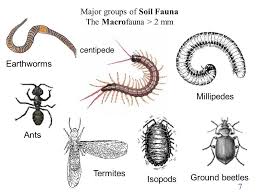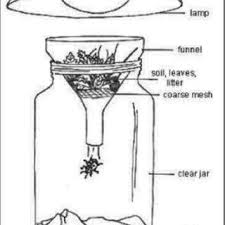Macrofauna: Difference between revisions
No edit summary |
No edit summary |
||
| Line 1: | Line 1: | ||
Macrofauna are the [[animals]] in the [[soil]] that can be seen by the naked eye. Macrofauna range from sizes of around 2mm to 20mm. These species easily move around in the soil and change the structure of the soil. Common species would be earthworms, myriapods, spiders and more. Macrofauna are important in the process of mixing soil and creating spaces within the soil. [[File:Soil_macrofauna2.jpg]] | Macrofauna are the [[animals]] in the [[soil]] that can be seen by the naked eye. Macrofauna range from sizes of around 2mm to 20mm. These species easily move around in the soil and change the structure of the soil. Common species would be earthworms, myriapods, spiders and more. Macrofauna are important in the process of mixing soil and creating spaces within the soil. [[File:Soil_macrofauna2.jpg|thumb|border|right|Several common macrofauna]] | ||
Macrofauna can have many roles in the soil such as soil engineers; who shape and structure the soil, shredders; who breakup [[Organic Matter|organic matter]] and predators. Macrofauna can also be used to determine soil quality due to their direct involvement in the soil. | Macrofauna can have many roles in the soil such as soil engineers; who shape and structure the soil, shredders; who breakup [[Organic Matter|organic matter]] and predators. Macrofauna can also be used to determine soil quality due to their direct involvement in the soil. | ||
==Sampling methods== | |||
Samples are taken by using the Berlese Funnel method, a method that forces fauna down a tunnel into a collection vessel due to their negative reaction to light. [[File:tullgren funnel.jpg|thumb|border|left|Image of Berlese Funnel]] | |||
==References== | |||
Revision as of 04:10, 30 April 2025
Macrofauna are the animals in the soil that can be seen by the naked eye. Macrofauna range from sizes of around 2mm to 20mm. These species easily move around in the soil and change the structure of the soil. Common species would be earthworms, myriapods, spiders and more. Macrofauna are important in the process of mixing soil and creating spaces within the soil.

Macrofauna can have many roles in the soil such as soil engineers; who shape and structure the soil, shredders; who breakup organic matter and predators. Macrofauna can also be used to determine soil quality due to their direct involvement in the soil.
Sampling methods
Samples are taken by using the Berlese Funnel method, a method that forces fauna down a tunnel into a collection vessel due to their negative reaction to light.
